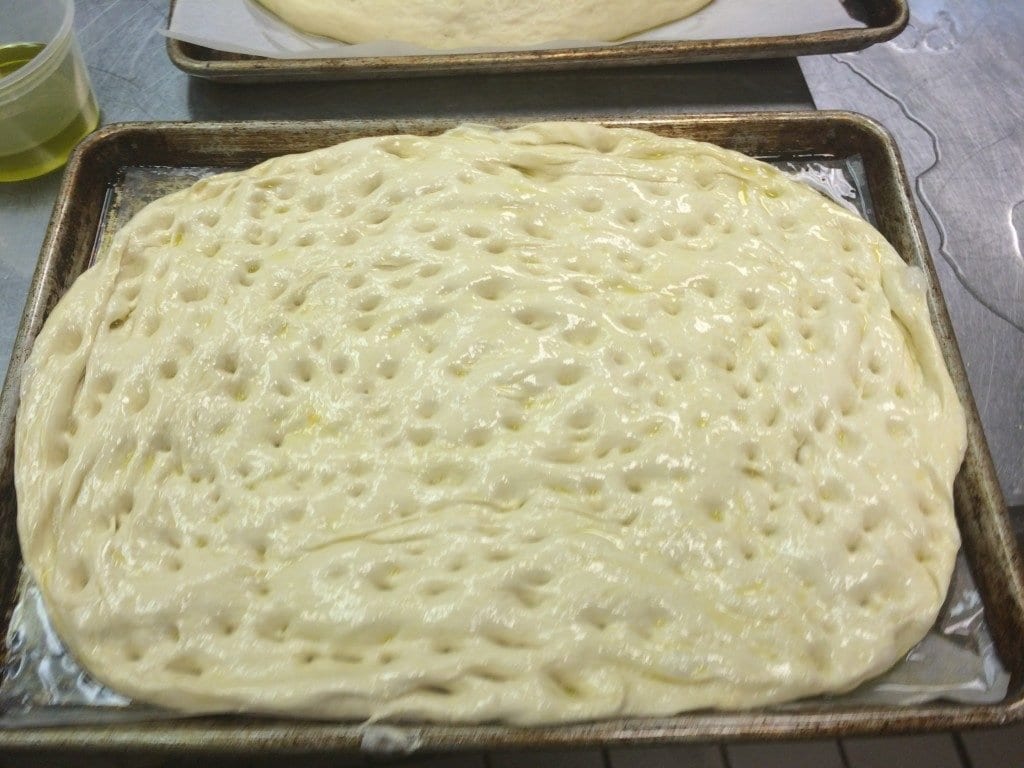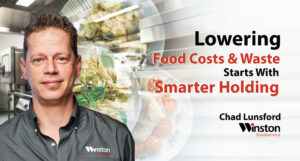Focaccia bread (Italian pronunciation: [foˈkattʃa]) is one of the most versatile breads. The bread can be baked thick or thin, and the endless array of topping choices compounds flavors in complex ways. Focaccia can be used in many ways, including as a pizza base, sandwich bread, or even as a cake.
Some folks are unaware that CVap® Cook and Hold Ovens and CVap Retherm Ovens are ideal for baking bread. In short, you can customize the oven’s environment to create the ideal proofing conditions.
Recipe:
- Bread Flour – 1.82 Kilograms
- Water – 845 Grams
- Fresh Yeast – 60 Grams
- Olive Oil – 140 Grams
- Salt – 60 Grams
- Sugar – 58 Grams

Method of Prep:
- First, preheat Cook and Hold Oven to Vapor 90°F/Air 95°F.
- Next, mix the water and flour. Autolyse for 20 minutes. Autolyse is a fancy word for mixing flour and water and allowing the mixture to rest for a few minutes.
- Add sugar, olive oil, and yeast, and mix for five minutes.
- Add salt and mix for two minutes.
- Transfer the dough to a half-sheet pan greased with olive oil.
- Place dough in the center of the pan. Stretch the dough into a flat oval. Be sure both sides are coated with olive oil.
- Finally, place the dough in Cook and Hold Oven to proof for an hour and 15 minutes.
- When the timer goes off, pull the dough from the oven.
- Punch and stretch the dough to the shape of the pan. Make indentations in the dough with your fingertips.
- Place the dough back in the oven and set a timer for 20 minutes.
- Remove the dough from the Cook and Hold oven and preheat to Vapor 200°F/Air 350°F.
- Top the dough with desired toppings and place back into the Cook and Hold Oven. Bake for 45 minutes.
One of our focaccia loaves was topped with charred ramps, roasted garlic, and rosemary. The other was topped with dried figs and fennel seeds. Both were seasoned with Maldon sea salt.
Consistent, efficient proofing is crucial when preparing leavened bread. CVap ovens create a consistent proofing environment. Their ability to maintain a stable, moist environment at a relatively low temperature makes them perfect proofers. Consequently, this generates the fermented smell and flavors of great bread. CVap ovens can adjust the cabinet environment to tailor the proof. As a result, you can create compound flavors while the bread is fermenting (or proofing).


The Results
The crumb on the finished product was excellent. It created a light, soft finished product, without making the exterior of the bread too hard.
You might notice in the pictures that one of the pans of focaccia was too close to the top elements. This was due to my portioning of the dough between the two pans. My bad.


Focaccia Fundamentals
Focaccia has a rich history. As you probably know, it’s Italian. Or to be more specific, it’s Roman. In ancient Rome, panis focacius was a flat bread baked on the hearth. The name is derived from Latin panem (bread) and focus (hearth, place for baking). The basic recipe is widely associated with Ligurian cuisine. The name focaccia first appeared in 1300C.E. But to be honest, breads have been baked on hearths for millennia. There are similar historical recipes throughout Turkey, Greece, France, Spain, and throughout the Middle East.
The popularity of focaccia spread with the Roman Empire. It was probably considered a poor man’s meal, baked to feed peasants and slaves. Today, savory, and sweet variations of focaccia can be found throughout Europe and the Americas.
It Ain’t Pizza
Because it’s a classic flat bread, focaccia is sometimes considered to be a kind of pizza. The key difference is that focaccia is left to rise after being flattened, whereas pizza dough is baked immediately. It’s worth noting that the flat bread of ancient Sicily was called pitu, a variant of the Greek pita. There’s a good chance pitu etymologically evolved into pizza. But as The New York Times’ Eileen Weinberg described it, “focaccia connotes bread with a little topping and pizza connotes topping with a little bread.”

Variations of Focaccia
Because it’s so versatile, there are many variations of focaccia. Here are just a few.
Fugassa
The OG focaccia, this Ligurian staple is seasoned with olive oil, rock salt, and herbs.
Recco Focaccia
From the Recco region, this version is made from unleavened dough. It’s worked thin, filled with fresh cheese (usually crescenza) and closed again, then fired.
Focaccia Barese
From the southern Italy town of Bari comes this version, made with durum wheat flour, and topped with rosemary, tomatoes, olives, and salt.
A Fugassa cö Formaggio
(focaccia with cheese) – Traditionally a specialty reserved for All Saints Day celebrations. It’s a layer of melted soft cheese sandwiched between two paper-thin layers of dough. It’s so revered in Italy that it was granted IGP (protected geographical indication) status by the European Union in 2012.
Schiacciata
Originating in the Tuscan region, this bread is usually thinner than the Genoa-style focaccia and is often topped with rosemary. It ends to have a soft interior yet be crispy on the outside. During the harvest months it’s common to make schiacciata all’ve where the bread is sweetened and stuffed with wine grapes.





